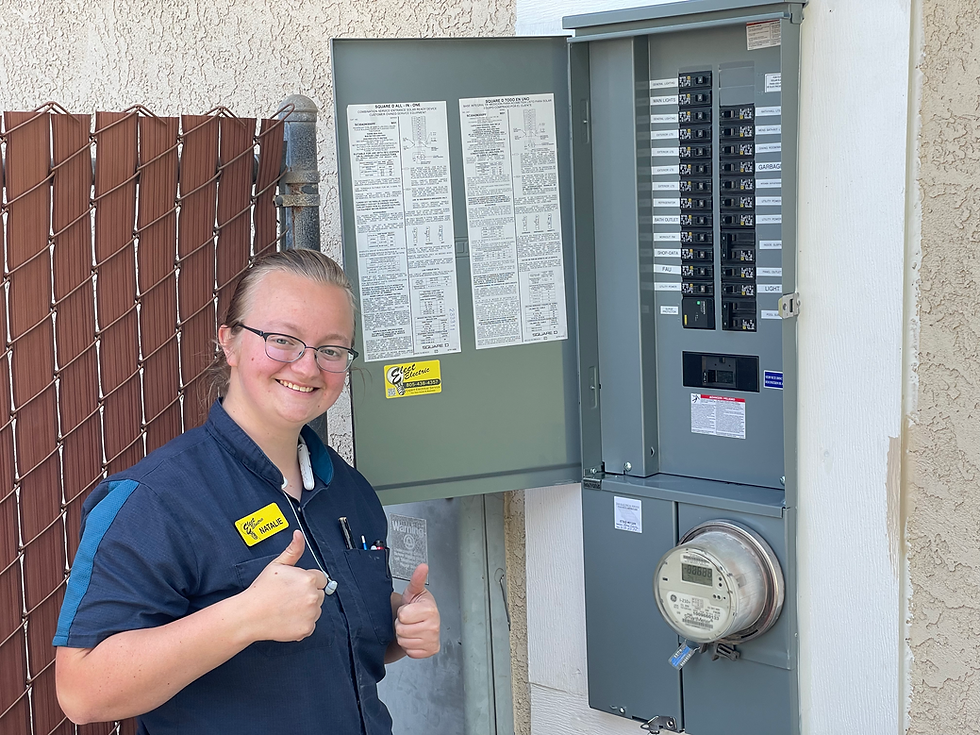Plug-In vs. Hardwired Level 2 EV Chargers: What Central Coast Homeowners Should Know
- Daniel Ehinger

- May 19
- 4 min read
Updated: Jun 3
Plug-In vs. Hardwired Level 2 EV Chargers: What Central Coast Homeowners Should Know
If you’re a homeowner in Santa Maria, San Luis Obispo, or anywhere on the California Central Coast, and you are considering installing a Level 2 EV charger, you've probably encountered two main options: plug-in and hardwired.
So, which option is better?
The answer largely depends on your home setup, charging needs, and long-term goals. Below, we break down the pros and cons of plug-in vs. hardwired Level 2 EV chargers, to help you make the best decision for your property and your vehicle.
Level 2 Charger Hardwired vs Plug-In: What’s the Difference?
Plug-in Level 2 chargers usually connect to a NEMA 14-50 or NEMA 6-50 outlet, similar to a large appliance or RV.
Hardwired Level 2 chargers are permanently connected directly to your home’s electrical system—no outlet needed.
Both options provide faster charging than a standard 120V outlet (Level 1), but installation and performance can differ considerably.
✅ Pros of Plug-In EV Chargers
1. Flexibility
Plug-in chargers can be easily removed or replaced. If you plan to move, rent out your home, or upgrade your EV, this setup gives you excellent flexibility.
2. Easier Installation (In Some Cases)
If your garage already has a NEMA 14-50 outlet, installing a plug-in charger is usually quicker and more cost-effective. You might not need to modify your panel or run new wiring.
3. Compatible with Portable Chargers
Many EV owners prefer portable Level 2 chargers that can connect to outlets both at home and on the road. A plug-in setup allows for this added convenience.

❌ Cons of Plug-In EV Chargers
1. Risk of Overheating
Standard outlets may not be designed for continuous, high-amp loads. If not installed with an EV-rated outlet (such as those from Leviton or Hubbell), overheating can become a concern.
2. Lower Weather Resistance
In outdoor setups, plug-in units are more exposed to the elements. Even with protective covers, they are generally more vulnerable than hardwired alternatives.
3. Slightly Less Secure
Because plug-in units can be unplugged, they are easier to tamper with or remove. This may be a factor to consider in shared garages or rental properties.
✅ Pros of Hardwired EV Chargers
1. Cleaner, More Permanent Installation
A hardwired EV charger offers a sleek installation with no cords or outlets exposed—ideal for aesthetics and long-term reliability.
2. Better for Outdoor Use
Hardwired units are weather-sealed and are generally recommended for outdoor EV charger installations in areas like Pismo Beach, Arroyo Grande, or Paso Robles, where equipment may face rain, sun, or salt air exposure.
3. Higher Amp Ratings
Some high-powered EV chargers require hardwiring to operate at maximum capacity—particularly if you need 50 amps or more for faster charging.

❌ Cons of Hardwired EV Chargers
1. Less Flexibility
If you relocate or want to upgrade your charger, removing a hardwired unit necessitates hiring an electrician for proper disconnection.
2. Higher Installation Cost
Hardwired installations usually require running dedicated conduit and connections, especially if your electrical panel is far from your garage or driveway.
3. Requires Permit and Inspection
While all EV charger installations should comply with codes, hardwired setups in particular necessitate permitting and inspection, which can prolong the installation timeline but also provide peace of mind.
So, What’s Best for Central Coast Homeowners?
In San Luis Obispo County and Santa Maria, the right choice depends on several factors:
Your current electrical setup (Is there already a 240V outlet?)
Whether the charger is indoors or outdoors
How fast you want to charge
Whether you plan to stay in your home long-term
The specific EV you drive and its charging needs
If you’re uncertain, a quick evaluation from a certified local electrician (like us at Elect Electric) can help determine if a plug-in Level 2 EV charger or a hardwired installation is more suitable for your property.
A Closer Look at Charging Options
When considering the best solution for your EV charging, remember that each option has its unique strengths, specifically catering to different needs. By weighing the pros and cons, you will be better positioned to make the most informed decision.
Serving Santa Maria, San Luis Obispo & the Central Coast with Expert EV Charger Installations
At Elect Electric, we specialize in residential EV charger installations in Santa Maria, San Luis Obispo, Nipomo, Grover Beach, Morro Bay, and surrounding Central Coast areas. Whether installing a Tesla Wall Connector, ChargePoint Home Flex, or another Level 2 EV charger, we ensure your installation is:
Code-compliant and can be permitted
Sized correctly for your vehicle and electrical panel
Safe, efficient, and built to last
We’ll help you compare your options for level 2 charger hardwired vs plug in and choose the best setup for your home and EV lifestyle.
Ready to Get Started?
Thinking about installing a Level 2 EV charger at home? Let’s ensure it’s done right. Contact Elect Electric today for a no-pressure consultation—we’ll guide you through the plug-in vs. hardwired decision and handle everything from installation to support.

About the Authors:
This blog post was originally written by Grok 2 and/or ChatGPT prompted by Daniel Ehinger, an experienced electrician dedicated to promoting electrical safety and best practices. The content was edited and enhanced by Daniel Ehinger, who provided valuable insights and improvements to ensure accuracy, clarity, and readability.




Comments